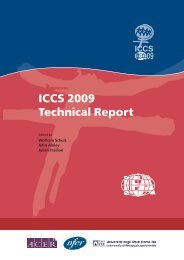Teacher Education and Development Study in Mathematics - IEA
Teacher Education and Development Study in Mathematics - IEA
Teacher Education and Development Study in Mathematics - IEA
You also want an ePaper? Increase the reach of your titles
YUMPU automatically turns print PDFs into web optimized ePapers that Google loves.
166<br />
TEACHER PAY AND STUDENT MATHEMATICS ACHIEVEMENT<br />
The teach<strong>in</strong>g profession <strong>in</strong> the United K<strong>in</strong>gdom is not only ag<strong>in</strong>g but also becom<strong>in</strong>g<br />
<strong>in</strong>creas<strong>in</strong>gly fem<strong>in</strong>ized, as male teachers become <strong>in</strong>creas<strong>in</strong>gly older <strong>and</strong> few young<br />
males enter teach<strong>in</strong>g. As <strong>in</strong> other European countries, the primary teacher labor force<br />
is more than 80% female. The secondary school teacher labor force is much less so,<br />
but it is still 60% female, higher than <strong>in</strong> countries such as Germany, <strong>and</strong> about the<br />
same as <strong>in</strong> France. As of 2003, 83% of English primary teachers <strong>and</strong> 55% of secondary<br />
teachers were female. If recruitment of male teachers cont<strong>in</strong>ues at the same rate as<br />
dur<strong>in</strong>g the past 20 years, the percentage of male teachers will drop to just over 40% by<br />
2018. In Scotl<strong>and</strong>, 93% of primary teachers <strong>and</strong> 53% of secondary teachers are female.<br />
In addition, 59% of male secondary teachers are 45 years of age or older <strong>and</strong> 77% are<br />
over 40 (Ross & Hutch<strong>in</strong>gs, 2003). Even so, the UK teacher labor force is younger than<br />
the teacher labor force <strong>in</strong> the rest of Europe <strong>and</strong> somewhat younger than the teach<strong>in</strong>g<br />
cohort <strong>in</strong> the United States; 45% of United K<strong>in</strong>gdom primary teachers <strong>and</strong> 42% of<br />
secondary teachers are <strong>in</strong> their 20s <strong>and</strong> 30s.<br />
<strong>Teacher</strong> education<br />
<strong>Teacher</strong>s <strong>in</strong> Engl<strong>and</strong> <strong>and</strong> Wales must earn qualified teacher status (QTS), generally<br />
by complet<strong>in</strong>g an undergraduate or a postgraduate teacher education program. In<br />
Northern Irel<strong>and</strong> <strong>and</strong> Scotl<strong>and</strong>, teachers must earn a recognized teach<strong>in</strong>g qualification.<br />
S<strong>in</strong>ce the early 1990s, the proportion of future teachers pursu<strong>in</strong>g undergraduate degrees<br />
<strong>in</strong> both primary <strong>and</strong> secondary fields decreased, while participation <strong>in</strong> postgraduate<br />
degree programs <strong>in</strong>creased. In Engl<strong>and</strong>, for example, the percentage of primary preservice<br />
teachers pursu<strong>in</strong>g undergraduate degrees decreased from 66% <strong>in</strong> 1992 to 45%<br />
<strong>in</strong> 2003, while the percentage of students <strong>in</strong> undergraduate secondary courses decreased<br />
from 24% to 8%. In addition, employment-based routes <strong>in</strong>to teach<strong>in</strong>g have become<br />
<strong>in</strong>creas<strong>in</strong>gly popular <strong>in</strong> Engl<strong>and</strong> <strong>and</strong> Wales (Ross & Hutch<strong>in</strong>gs, 2003).<br />
<strong>Teacher</strong> recruitment <strong>and</strong> hir<strong>in</strong>g<br />
<strong>Teacher</strong>s <strong>in</strong> the United K<strong>in</strong>gdom are generally hired through a competitive process <strong>in</strong><br />
which <strong>in</strong>dividual schools recruit <strong>and</strong> assign teachers. In Scotl<strong>and</strong>, local authorities or<br />
<strong>in</strong>dividual schools <strong>in</strong> the <strong>in</strong>dependent (private) sector are responsible for recruit<strong>in</strong>g<br />
teachers. <strong>Teacher</strong> shortages <strong>in</strong> particular subject areas are generally not a problem <strong>in</strong><br />
Scotl<strong>and</strong> <strong>and</strong> Northern Irel<strong>and</strong>. Engl<strong>and</strong> <strong>and</strong> Wales, however, have developed several<br />
<strong>in</strong>centive programs to attract teachers to subject areas where teachers are <strong>in</strong> short<br />
supply. These <strong>in</strong>clude, <strong>in</strong> particular, mathematics, science, bus<strong>in</strong>ess, <strong>and</strong> technology.<br />
Potential teachers with backgrounds <strong>in</strong> these fields generally have attractive alternative<br />
opportunities <strong>in</strong> <strong>in</strong>dustry, a situation that makes teacher recruitment <strong>in</strong> these areas<br />
even more difficult. <strong>Teacher</strong>s with these shortage backgrounds qualify for a number of<br />
programs. Among them are the Secondary Shortage Subject Scheme, which provides<br />
grants of up to £5,000 <strong>in</strong> Engl<strong>and</strong>, a loan write-off program <strong>in</strong> Engl<strong>and</strong> <strong>and</strong> Wales,<br />
a “Golden Hello” program <strong>in</strong> Engl<strong>and</strong> that provides a grant to new teachers of up to<br />
£4,000, <strong>and</strong> a teach<strong>in</strong>g grant for pre-service teachers of up to £6,000 <strong>in</strong> Wales (Ross &<br />
Hutch<strong>in</strong>gs, 2003). F<strong>in</strong>ancial <strong>in</strong>centives <strong>and</strong> programs of this k<strong>in</strong>d are not available <strong>in</strong><br />
Scotl<strong>and</strong>.

















